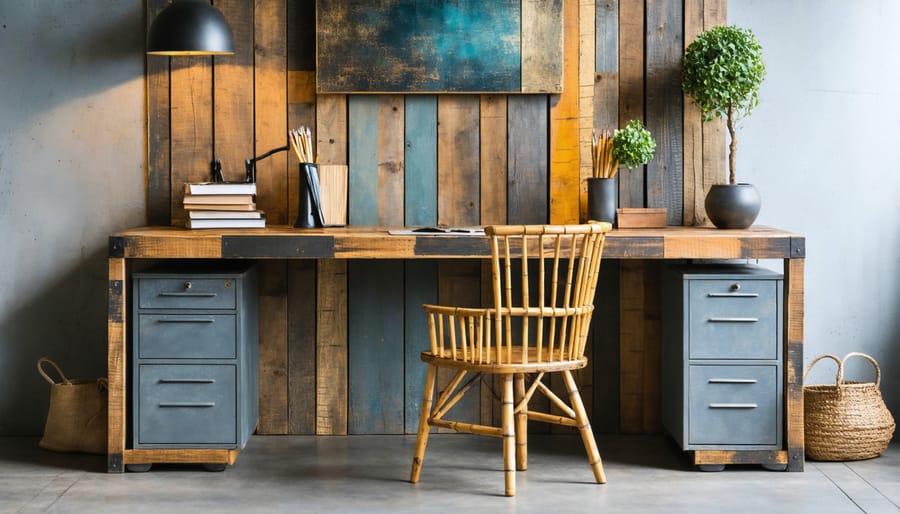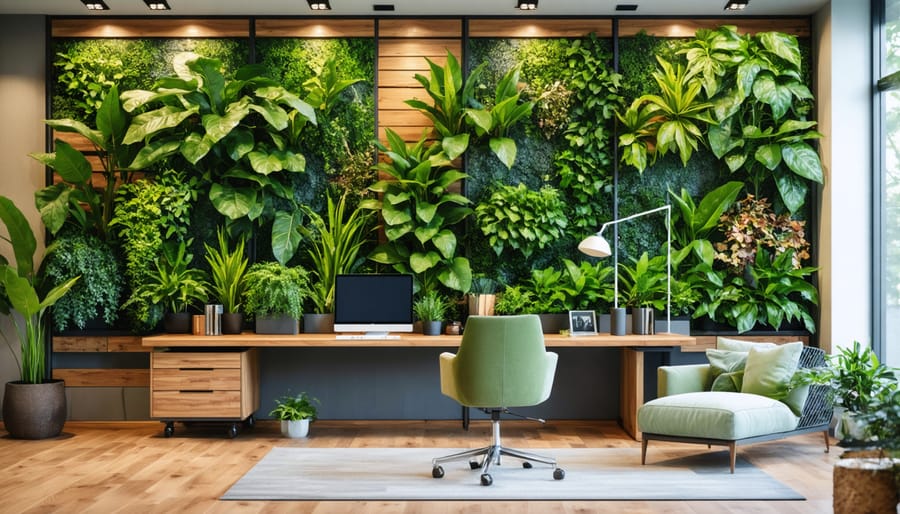Transform your living and working spaces into sustainable sanctuaries with innovative design solutions that blend beauty, functionality, and environmental responsibility. From reclaimed wood furniture to energy-efficient lighting systems, sustainable design has evolved far beyond basic recycling bins and LED bulbs. Today’s eco-conscious creators are reimagining everyday spaces with biophilic elements, smart resource management, and materials that tell stories of environmental stewardship.
Modern sustainable design celebrates the intersection of nature and technology, where solar-powered smart homes feature living walls, and 3D-printed furniture uses biodegradable materials. These thoughtful approaches not only reduce our environmental footprint but also create healthier, more inspiring spaces that connect us with the natural world. Whether you’re planning a complete home renovation or seeking small yet impactful changes, sustainable design offers practical solutions that benefit both your lifestyle and the planet.
The most successful sustainable designs seamlessly integrate three key elements: energy efficiency, renewable materials, and waste reduction. By incorporating these principles into our living spaces, we create environments that nurture both human wellbeing and ecological balance. Let’s explore how these innovative approaches are reshaping our homes, offices, and public spaces for a more sustainable future.
Natural Light and Energy-Efficient Lighting Solutions
Maximizing Natural Light
Maximizing natural light isn’t just about reducing energy costs – it’s about creating a vibrant, healthy living space that connects you with the outdoors. Start by evaluating your windows’ placement and size. South-facing windows typically provide the most consistent daylight throughout the year, while north-facing windows offer soft, diffused light that’s perfect for workspaces.
Consider installing larger windows or adding skylights in darker areas of your home. Light tubes or solar tubes are excellent alternatives for rooms where traditional windows aren’t feasible. They channel sunlight from your roof through a reflective tube, bringing natural light into previously dim spaces.
Strategic mirror placement can amplify natural light by reflecting it deeper into rooms. Choose light, reflective colors for walls and ceilings to help bounce light around the space. Remove heavy window treatments or replace them with sheer fabrics that filter light while maintaining privacy.
Don’t forget about light shelves – these horizontal surfaces installed above eye level reflect sunlight deeper into rooms while providing shade from direct glare. For maximum efficiency, keep windows clean and trim any outdoor vegetation that might block natural light from entering your home.

Smart LED Lighting Systems
Smart LED lighting systems have revolutionized how we think about illuminating our spaces sustainably. By incorporating energy-efficient LED lighting into your home, you can reduce electricity consumption by up to 75% compared to traditional bulbs while enjoying better light quality and control.
These intelligent systems go beyond simple on/off functionality. With smart controls, you can adjust brightness levels throughout the day, automatically dim lights when natural sunlight is available, and even create custom lighting schedules that match your daily routine. Motion sensors ensure lights only operate when needed, while color temperature adjustments help maintain your natural circadian rhythm.
Installing smart LED systems is surprisingly straightforward. Many options work with existing fixtures and can be controlled through user-friendly smartphone apps or voice commands. You can start small with a few basic bulbs and gradually expand your system as needed.
For the best results, consider placing task lighting in work areas, ambient lighting for general illumination, and accent lighting to highlight specific features. Remember to look for ENERGY STAR certified products to ensure maximum efficiency and reliability. The initial investment typically pays for itself through reduced energy bills within two years.
Eco-Friendly Furniture and Materials
Reclaimed and Recycled Furniture
Embracing reclaimed and recycled furniture is one of the most impactful ways to create a sustainable home office. By exploring creative sustainable furniture options, you can reduce environmental impact while adding unique character to your space.
Consider salvaged wood desks, which tell a story through their weathered patina while keeping valuable materials out of landfills. Local salvage yards, antique shops, and online marketplaces are excellent sources for finding these gems. Look for solid wood pieces that can be restored – they often outlast modern particleboard furniture.
Upcycling existing furniture offers another creative approach. That old dresser could become a stylish filing cabinet with fresh paint and new hardware. Metal filing cabinets can be transformed with chalk paint and decorative elements into statement pieces that blend functionality with style.
Don’t overlook the potential of unexpected materials. Wooden pallets can be reimagined into shelving units or standing desks. Wine crates make excellent storage solutions when stacked creatively. Even old doors can find new life as a spacious desk surface when paired with sturdy legs.
When shopping for new pieces, prioritize furniture made from recycled materials like reclaimed metal, plastic, or composite wood products. Many contemporary manufacturers now offer beautiful designs that incorporate post-consumer materials without sacrificing style or durability.
Remember to consider the longevity of your choices – pieces that can be easily repaired or updated will serve you well for years to come.

Sustainable Material Selections
Choosing sustainable materials for your office furniture and decor doesn’t mean compromising on style or functionality. Start with reclaimed or recycled wood for desks and shelving – these pieces add character while giving new life to existing materials. Bamboo is another excellent choice, as it grows quickly and requires minimal resources to harvest and process.
For office chairs and seating, look for pieces made with recycled metals and plastics, or opt for furniture featuring organic fabrics and natural filling materials like cotton, wool, or hemp. Many manufacturers now offer office chairs made from ocean-bound plastics or recycled car parts, proving that sustainability can be both innovative and comfortable.
When it comes to decor, consider cork for bulletin boards and wall coverings – it’s naturally renewable and adds warmth to your space. For window treatments, choose organic cotton or linen curtains, which are both biodegradable and free from harmful chemicals. Plant-based materials like seagrass or jute make excellent choices for area rugs and storage baskets.
Don’t forget about finishes and adhesives – opt for water-based, low-VOC products to maintain healthy indoor air quality. Many eco-friendly alternatives now perform just as well as their traditional counterparts. When shopping, look for certifications like FSC (Forest Stewardship Council) for wood products or GREENGUARD for furniture and materials with low chemical emissions.
Remember, the most sustainable choice is often to repurpose what you already have or buy second-hand when possible. With a bit of creativity, you can create an environmentally conscious office space that’s both beautiful and responsible.
Energy-Efficient Technology Setup
Energy-Saving Devices
Choosing energy-efficient office equipment is one of the smartest ways to boost your energy efficiency while creating a sustainable home office. Start with ENERGY STAR certified devices, which typically use 60-70% less electricity than standard models. Look for laptops instead of desktop computers when possible, as they consume up to 80% less power.
Smart power strips are your secret weapon in fighting phantom energy drain. These intelligent devices automatically cut power to peripherals when your main device, like your computer, goes into sleep mode. Some models even come with motion sensors that power down everything when you leave the room.
Consider LED desk lamps with adjustable brightness settings and automatic shutoff features. For printing needs, choose an efficient inkjet printer over a laser printer – they use significantly less energy and are perfect for home office use. Remember to enable power-saving modes on all your devices and set them to sleep after short periods of inactivity.
Don’t forget about natural light! Position your desk near a window to reduce reliance on artificial lighting during daylight hours. When you combine these energy-efficient devices with mindful usage habits, you’ll see a noticeable difference in both your energy bills and environmental impact.
Smart Climate Control
Smart climate control is all about creating a comfortable environment while minimizing energy consumption. Start with a programmable or smart thermostat that learns your schedule and adjusts temperatures automatically. These devices can reduce your heating and cooling costs by up to 10-15% annually while keeping you comfortable throughout the day.
Natural ventilation strategies play a crucial role in sustainable climate control. Position windows and vents to create cross-breezes, and consider installing ceiling fans to improve air circulation. During warmer months, use window treatments strategically – close blinds during peak sun hours and open them when temperatures cool down.
For more targeted climate management, explore zoned heating and cooling systems. These allow you to control temperatures in different areas independently, avoiding the waste of heating or cooling unused spaces. Complement these systems with proper insulation in walls, floors, and ceilings to maintain desired temperatures more efficiently.
Smart sensors can take your climate control to the next level by monitoring occupancy, humidity, and air quality. These devices work with your heating and cooling systems to maintain optimal conditions while using minimal energy. Consider adding humidity control features to maintain comfortable moisture levels without excessive energy use.
Remember to regularly maintain your HVAC systems and clean air filters monthly for maximum efficiency and longevity.
Biophilic Design Elements
Indoor Plants and Living Walls
Indoor plants are more than just decorative elements – they’re natural air purifiers and mood boosters that can transform your workspace into a healthier environment. Start with low-maintenance options like snake plants, pothos, or ZZ plants, which thrive in office conditions and excel at removing common air pollutants.
Consider creating a living wall, which maximizes vertical space while making a stunning visual impact. You can start small with a modular system that holds 4-6 plants and expand over time. Look for plants like philodendrons, ferns, and peace lilies that grow well in vertical arrangements.
For best results, position plants near your workspace but away from air vents. Establish a simple care routine: check soil moisture weekly, dust leaves monthly, and rotate plants quarterly for even growth. Group plants with similar water needs together to streamline maintenance.
Remember to choose pet-friendly varieties if you have animals at home, and opt for self-watering containers if you’re often away from your office. With proper planning, your indoor garden will provide years of natural air filtration and biophilic benefits.

Natural Materials and Textures
Natural materials bring warmth and authenticity to sustainable design while reducing environmental impact. Consider incorporating materials like reclaimed wood for furniture and accent pieces, which adds character while preventing deforestation. Bamboo is another excellent choice, offering durability and rapid renewability – it grows much faster than traditional hardwoods.
Cork stands out as a versatile material that’s both sustainable and functional. Use it for flooring, wall coverings, or bulletin boards. It’s naturally antimicrobial, sound-absorbing, and harvested without harming trees. Natural stone, like slate or limestone, makes for stunning countertops and decorative elements that last generations.
Bring texture into your space with organic fabrics like hemp, organic cotton, and wool. These materials are biodegradable and often require fewer pesticides to produce. Consider sisal or jute rugs, which add earthy appeal while being fully biodegradable. Natural clay plasters and lime-based paints offer chemical-free alternatives for wall finishes, improving indoor air quality while creating beautiful, textured surfaces.
Remember, the key is to choose materials that are both environmentally responsible and aesthetically pleasing, creating a space that feels connected to nature.
Waste Reduction Strategies
Paper-Free Solutions
In today’s digital age, embracing paper-free solutions is easier and more practical than ever. Start by switching to digital note-taking apps like Evernote or OneNote for all your planning and brainstorming needs. Cloud storage services eliminate the need for physical file storage while making document sharing and collaboration seamless. Consider investing in a tablet with a stylus for sketching and annotations – it provides the familiar feel of writing while maintaining a sustainable approach.
For unavoidable paper usage, implement a robust digital filing system and scan important documents immediately. Set up automated bill payments and request electronic statements from service providers. When exploring eco-friendly DIY solutions, create a designated spot for paper recycling and use digital sticky notes instead of physical ones. Remember, even small changes in paper consumption can lead to significant environmental impact over time, while also keeping your space cleaner and more organized.
Recycling Systems
Setting up an effective recycling system is a cornerstone of sustainable design that’s easier than you might think. Start by creating a dedicated sorting station with clearly labeled bins for different materials – paper, plastic, glass, and metal. Consider adding a compact compost bin for food scraps and organic waste, which can later nourish your indoor plants or garden.
Make your recycling station both functional and aesthetically pleasing by choosing bins that complement your space’s design. Modern options include sleek, built-in cabinet solutions or stylish bamboo containers that blend seamlessly with your decor. Place these stations in convenient locations where waste typically accumulates, like near your desk or in the kitchen.
For maximum efficiency, post simple recycling guidelines above your sorting station and maintain a small container for hard-to-recycle items like batteries and electronics. This systematic approach not only reduces waste but also creates an organized, eco-conscious environment that inspires sustainable habits in everyone who uses the space.
Creating a sustainable home office isn’t just about following trends – it’s about making conscious choices that benefit both our environment and our wellbeing. By implementing the sustainable design practices we’ve explored, you can create a workspace that’s not only eco-friendly but also more productive and enjoyable.
Remember that sustainability doesn’t require a complete office overhaul. Start with simple changes like maximizing natural light, choosing energy-efficient equipment, and incorporating plants. As you become more comfortable with these changes, you can gradually implement more comprehensive solutions like renewable materials and smart technology.
The key is to find the right balance between functionality and environmental responsibility. Whether you’re working with a dedicated home office or a small corner workspace, every sustainable choice makes a difference. Consider which of these design elements best suits your needs and budget, then take action to create your ideal eco-friendly workspace.
By making mindful decisions about our work environments today, we’re investing in a healthier planet for tomorrow. Start your sustainable office journey with one small change – you might be surprised at how naturally the rest follows.
